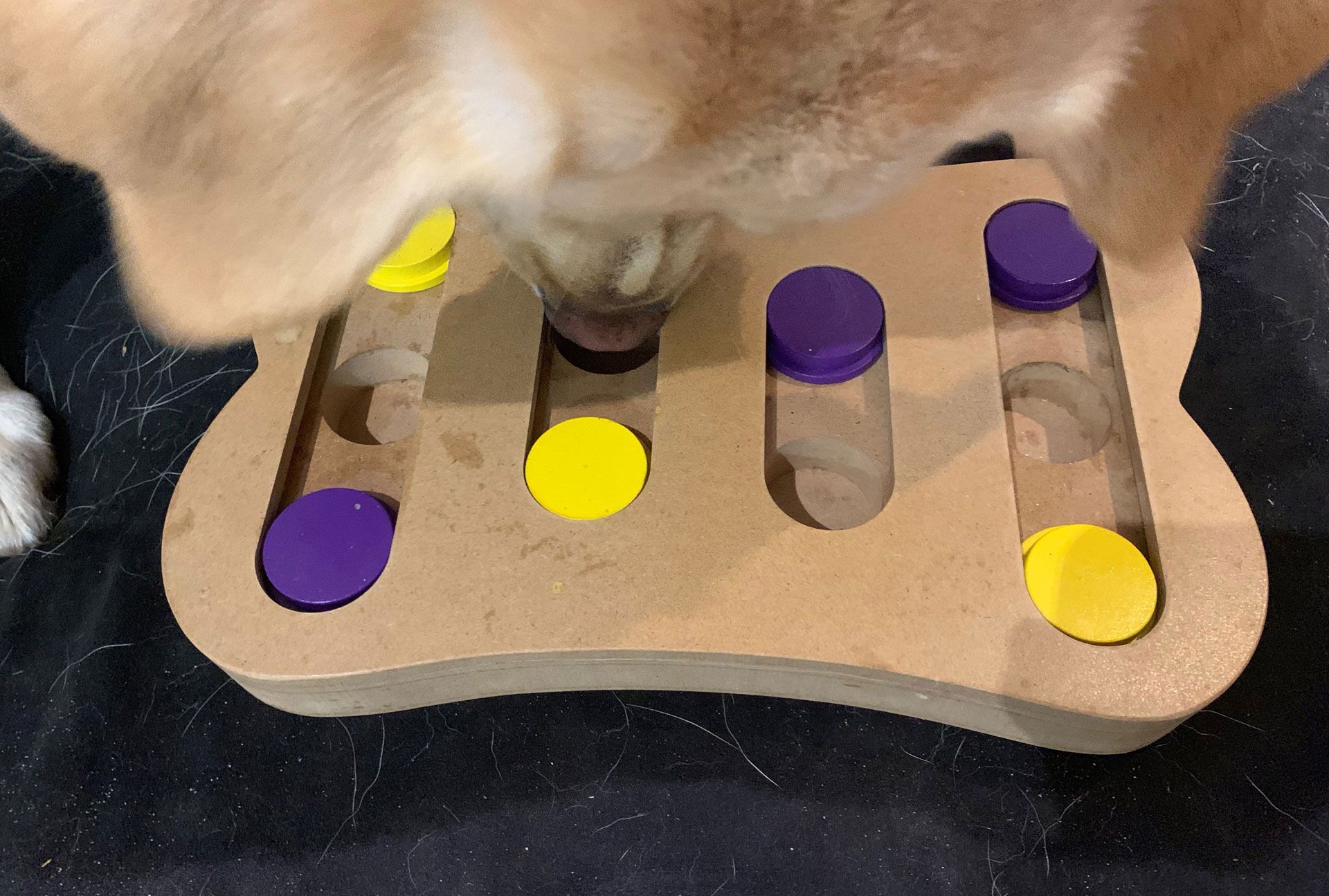Affordable therapy for canine dementia
Dr Aine Seavers MVB MRCVS writes about a simple, affordable, anti-anxiety medication to slow the clinical expression of canine cognitive disorder (dog dementia)
Canine cognitive disorder (CCD) is a stand-alone, geriatric onset, behavioural problem not induced by a general medical condition. The main purpose of this article is to provide vets with information on the affordable, safe and effective use of beta blockers such as Propranolol in these canine dementia patients. Knowing about this affordable, accessible medication as a treatment option is important for many owners who simply cannot afford the dramatically more expensive primary veterinary cognitive disorder medications. This article also includes a summary of non-pharmacy adjuncts to assist in the management of any canine dementia case.
There are four categories of CCD including;
Disorientation in home and yard;
Changes in social interaction with family;
Decline in house training;
Alteration of sleep-wake cycles.
The signs need to be persistent for at least some weeks to be suggestive of the disorder.
Many clients tolerate the first two to three symptoms as a sign of old age and slowing down, but the owners have a very poor tolerance of the sleep-wake cycle disorder, as they themselves soon get to be included in the new sleep-deprived regime and at that point quickly seek veterinary assistance!
Most canine dementia cases seem remarkably well for their geriatric age and often no cardiac/renal or hormonal disorders can be linked to the night-time pacing in and out and lack of deep sleep (for all the family). A work-up, including blood draws, ultrasound etc., is preferred but many clients are overly reluctant to submit their elderly pets to much intervention. The workaround is to start providing safe, affordable and effective drug and environmental enrichment to these pets until such time as the owner agrees or sees the need to investigate further.

General supportive therapy includes providing dog puzzle toys.
PHARMACY
There are many registered veterinary medicines now available such as Selegiline, Nicergoline, Propentofylline, Sileo plus human drugs like Gabapentin, Xanex etc. While their efficacy is not in doubt, the cost can be a prohibitive factor, especially in a large or giant-breed, uninsured dog. Aggression and altered mentation in the pet can also be a side effect of these medications, a behaviour change that owners can find distressing and confronting.
In dogs, the much-respected JSAP Drug Formulary1 notes Propranolol’s use in behavioural therapy to reduce somatic signs of anxiety as being useful in the management of situational anxieties and behavioural problems where contextual anxiety is a component.
Propranolol is a cheap and easily available medication and is available in most countries in up to four sizes. You do need to carefully check your drug formulary re: Propranolol to look for any drug interactions such as insulin/terbutaline/diazepam/diuretics/thyroid/digoxin/Phenobarb/Lignocaine etc.
Propranolol is contraindicated in animals with supraventricular bradycardia, and AV block, and cautioned in cases with congestive heart failure. Propranolol is, however, indicated in cachexia cases especially cardiac conditions so the presence of heart disease per se does not rule out the sensible use of Propranolol.
Additional positive effects have been reported in patients with severe burns, in whom beta-blockers have been shown to reverse excess protein catabolism. Propranolol treatment yielded a decrease in resting energy expenditure; net muscle-protein balance increased by 82 per cent over baseline values in the Propranolol group and decreased by 27 per cent in the control group. The fat-free mass, as measured by whole-body potassium scanning, did not change substantially in the Propranolol group, whereas it decreased by a mean of 9±2 per cent in the control group (p=0.003)2.
Overall, as mentioned earlier, most of the CCDs are remarkably healthy geriatrics that can spend all night on the move with zero signs of exercise intolerance or fatigue etc. Many have difficulty retaining weight as they are so constantly on the move and often forget to eat unless food is physically placed in front of them. Thus, Propanol’s ability to reverse excess protein catabolism provides another indication for the use of the drug in canine dementia cases.
Propranolol – unlike some vet-registered expensive drugs – does not increase aggression so I can use it in multi-dog households.
I have used Propranolol since the late 1980s for these dementia cases and found it to be superb in extending the quality of life of my CCD cases. I have recommended this drug therapy to fellow vets on international vet internet lists and the feedback has been positive. Since I first made Australian vets aware of this use many years ago, via a published snippet on my approach, I now receive a constant stream of excellent feedback about Propranolol’s positive effect on canine CCD patients.
Locums in particular seem to have embraced the concept. Canine dementia is widespread, and the Propranolol is easily accessible in any area regardless of the remoteness of the location, as long as there is a pharmacist in town plus the drug remains affordable, regardless of the socioeconomic status of the area and the client.
Owners comment they go from one night’s sleep in 14 to 13 out of 14 nights of good sleep.
Response in very early cases can be within 48hrs, but normally I don’t expect much change in the pet’s behaviour for about two weeks.
Because the drug is affordable, you get great client compliance, whereas with Nicergoline, Propentofylline, etc, the cost makes the client expect a cure overnight and they are less tolerant of the time lag to effect. Those client issues don’t arise with Propranolol use.
Tangential use of Propranolol in PTSD/noise phobia
In 2010, I started trialling any age of dog with separation and anxiety and/or noise phobias on Propranolol as it had worked so well on the fearful part of many canine dementia cases.
I had become aware that PTSD researchers, with a particular focus on noise-triggered PTSD in humans, were taking what was known as to how memory is stored and combining that knowledge with neuroplasticity developments to place a PTSD person on Propranolol. The PTSD sufferer is then made to actively remember their trauma. As the PTSD person recalls that memory from storage in their brain and then later acts to return that same memory to storage, Propranolol changes the protein synthesis of memory, so the rewritten information going back to the memory bank is now less vivid, less painful, and less traumatic. The process is repeated weekly until one presumes the whole memory is so rewritten that it is no longer fearful. The therapy is most effective when the triggers are sound-based, i.e., thunder, storms, gunshots, explosions etc.
Any animal, human or dog etc, can’t learn when they are suffering from PTSD or extreme anxiety. In such a raw unmedicated state, ‘teachable’ moments are few and far between. Propranolol gradually frees the patient from the bad memory syntax so that when given controlled, gentle exposure to its fear trigger, the patient can be taught how to view the trigger in a new way and hence respond more safely and healthily.
As a result of that human research work, and as part of a wider work-up behaviour programme, I start all my noise-phobic, younger patients on Propranolol from day one. Initially, we work with the dog and their chosen, trusted human protector in a safe environment to change the narrative of what that noise used to represent. However, just because I get better results with Propranolol in noise-phobic dogs than with other medications, that doesn’t mean that medication alone is all that is needed in these cases. One still has to manage, monitor and modify the environment and treatment programme, the same as with any other behaviour medication method.

Taking a dog out for a walk, gives the animal’s sense of smell a good workout.
Dosage
I medicate at 1mg/kg every 12 hours (behavioural dose range is 0.5-3.0mg/kg PO sid/bid) but I take seven days to get to that dose as I phase the drug in most cases. I tell clients not to expect much for the first 14 days, though some clients report earlier efficacy. Therapy is efficacious for about 18 months, then it starts to fail.
Upping the dose to 2.5-3mg/kg bid at that stage then produces a response for a further three to four months, during which we offer the more mainstream veterinary behaviour drugs above. Clients are happier to move up at this point but expense, not efficacy, usually sees them request euthanasia a couple of months afterwards.

A homemade snuffle mat.
The only two cases where Propranolol has failed me has been in two female cross-bred terriers with central blindness as a major clinical factor in the presentation. Both eyes had a normal ocular exam, one could visualise normal retinal structures and normal optic discs, absence of glaucoma but the dogs were blind and with the additional classic signs of dementia. In those cases, Propranolol will not work. Fish oils are of better palliative assistance in such cases (180EPA/120DHA per 4.5kg is the ratio I look for in the over-the-counter fish oil capsules).
In summary: the anxious, sudden-onset but persistent, aimless barking and sleep-deprived senior dog in the backyard may well be a CCD case. Cheap, effective, easily obtained Inderal/Propranolol for those for whom cost is an issue can dramatically extend and improve the quality of life for the patient and their family when euthanasia was the only other option. Propranolol can save lives: consider it as part of a total package of treatment for CCD.
Adjunct therapies for canine cognitive disorders
Time zones
“Sundowning” Alzheimer-like manifestations do occur in dogs; my own UK rescue geriatric cross-bred GSD exhibited classic signs. A personal conversation with Professor Karen Overall back in the early 1990s confirmed my suspicions that this dog had Sundowners; not ‘old dog distemper’ as so many old dogs with dementia used to be diagnosed with back in those days. For this particular presentation of canine cognitive disorder, one could trial specific lights similar to wattage used to treat depression in humans affected by lack of natural sunlight or seasonal affected disorder (SAD). The SAD lights go on just when one wants the dog to wake up normally. Run these SAD lights for about 30mins. In the afternoon, normal household lights are switched back on just before the evening light begins to slip away. These can be outdoor lights on sensors or just involve turning the lights on in the house from around 3.30pm in winter if the dog lives inside. Turn off these lights when you go to bed, so the dog understands it is now night. It is very useful to have dimmer switches on any of the lights as these work well to drop the total light slowly over 30-40mins.
Light Emitting Diodes, or fibre optic blinking, or new age lights are also used as a unisensory therapy to stimulate brain functioning. A note of caution however with their use, as the more we learn about photobiomodulation (PBM), the more we know that we should not be so blasé about the indiscriminate use of these laser play lights etc. There is a growing body of concern that probably more absorption of these blue lights by the eyes occurs than we have hitherto been told.3 My preference is to use PBM light sources with respect and keep them for medical therapy time, not home playtime.
However, transcranial PBM/laser medical therapy4, using large wavelengths in the Red/Near IR wavelengths has shown some promising results in human medicine for dementia cases and we are now carefully extrapolating this work across to our canine patients, so watch this space.
Diet
Feed specific diets like Hills B/D, sardines, and fish oil supplementation, and ensure that any raw meat is always fed with some cooked carbohydrates.
Fish-based, omega 3-oil capsules with a 180EPA/120DHA per 4.5kg are currently recommended5 for cardiac and cachexia in old dogs, so I just use that dose. (Don’t use flaxseed generally as it is Omega 3 in the form of ALA, the conversion of which to EPA/DHA is apparently inefficient both in dogs and in people and nearly non-existent in cats). However, I do prefer sardines as my Omega source for dogs, having once read some obscure trial whereby the humble sardine outperformed just about any human-manufactured EFA supplement.
I have the owner feed a half to one sardine every second day for one week, then up to one sardine per 15kg dog every other day as maintenance. Monitor for sloppy stools and back off down to the previous portions, if so. Either select the cans of sardines in spring water form or read the content of any sardines-in-oil variety as, apparently, the oil in many sardine cans is not sardine oil. Virbac’s Megaderm is also a good EFA source as are some of the better veterinary CCD dementia supplements.
Carbohydrate meals help, both with sleep and with calming. Due to the digestive pyschodietetics6 for raw meat, a meat-only dinner results in very little tryptophan getting across the blood-brain barrier (BBB), which means less serotonin is then produced. One needs to add carbohydrates to the meat meal in order to up the tryptophan BBB transfer from the food. If close to Christmas, check if there is any left-over turkey and have the owners freeze it into portions to feed it at night with some pasta. That way you combine the turkey, a great natural source of tryptophan, with the carbs as a way to increase the amount of tryptophan crossing across the blood-brain barrier.
If the dog is tending to stay awake all night and sleep all day, then switch the feeding times by 12 hours as that can help settle some of the aberrant sleep patterns.

Owners should consider taking a truly infirm or anxious dog out for a drive in the car to a park to relax and watch the world go by.
Exercise
General supportive therapy includes physiotherapy sessions, massage, a homemade low-level obstacle course, and brain exercises, such as providing dog puzzle toys and snout-work, homemade snuffle mats, etc.
Walks are an important factor in providing both general muscle use and plenty of olfactory stimulation. We take our dogs for walks to stimulate their muscles, their heart and their sense of smell. Whilst walking per se is beneficial for dogs with cognitive function,7 the main benefit is to give the dog’s sense of smell a good workout. For this reason, ensure some part of the walk is done at a pace that allows the dog the opportunity to do lots of sniffing and scenting along the way.
Likewise, the use of increasingly popular, purpose-built dog strollers means these old dogs can be taken outdoors and slowly pushed along so they can get to appreciate the many smells on the walk.

Purpose-built strollers allow old dogs to be taken outdoors and slowly pushed along so they can appreciate the many smells on the walk.
For truly infirm, anxious, elderly dogs, consider just taking the dog out for a drive in the car to the beach or park to watch the world go by.
As olfaction is the dominant scent by which dogs perceive their world, it is really important to continue to provide ways for a dog to do a scent hunt at home, i.e., using snuffle mats, treat treasure hunts, etc
Safe zones
The den is just a safe space or bolthole the dog can access when their anxiety soars, as simple as an understairs cupboard, an old linen press, an outdoor dog crate, or a small shed, that they can wander into where it’s safe, warm, and well-lit. This safe zone should be the site where the dog always first gets their favourite food treats and toys and where there is always a garment previously worn by the owner to keep the pheromone levels elevated in that area. A plug-in diffuser Adaptil pheromone or Adaptil spray is also useful in these areas.
- BSAVA Small Animal Formulary- Bryn Tennant.
- Herndon, D. N., et al. Reversal of catabolism by beta-blockade after severe burns. N Engl J Med 2001; 345:1223−1229.
- Wang et al 2017. Red (660 nm) or near-infrared (810 nm) photobiomodulation stimulates, while blue (415 nm), and green (540 nm) light inhibits proliferation in human adipose-derived stem cells. Scientific Reports 2017 Vol 7; No: 7781.
- Zomorrodi et al. Pulsed Near Infrared Transcranial and Intranasal Photobiomodulation Significantly Modulates Neural Oscillations: a pilot exploratory study. Scientific Reports 2019 Vol 9; Number 6309.
- Freeman, LM. Review; Beneficial effects of omega-3 fatty acids in cardiovascular disease. J Smal Anim Prac 2010: 51(9):462-70.
- Ballarini LJG. Animal Psvchodietetics. J. Smal Anim Pract 1990:31:523-532.
- https://www.washingtonpost.com/wellness/2022/11/16/dogs-dementia-exercise/?wpisrc=nl_sb_smartbrief&utm_content=ADBC6892-6683-46AA-BE52-8040EFBD9202. Accessed 20/05/2023
1 Which is the first sign most often displayed by the canine cognitive disorder patient?
A. Loss of orientation in home and yard
b. Changes in social interaction with family
c. Decline in house-training
d. Alteration in the sleep-wake cycles
2 Which of the following drugs have some interaction with propranolol?
A. Insulin
b. Diazepam
c. Diuretics
d. All of the above
3 What is the Behavioural Dose range for Propranolol?
A. 0.1mg/kg once daily
b. 0.5mg/kg PO once daily
c. 0.5-1.0mg/kg PO once daily
d. 0.5-3.0mg/kg PO every 12 hours
4 Which is not a supportive therapy for CCD patients?
A. A diet poor in essential fatty acids
b. Adding carbohydrates to any raw meat meal
c. Muscle and brain exercise with a particular focus on olfactory stimulation
d. Provision of a den or safe zone with attention to increasing lighting and positive pheromone levels within said zone.
ANSWERS: 1A; 2D; 3D; 4A.















